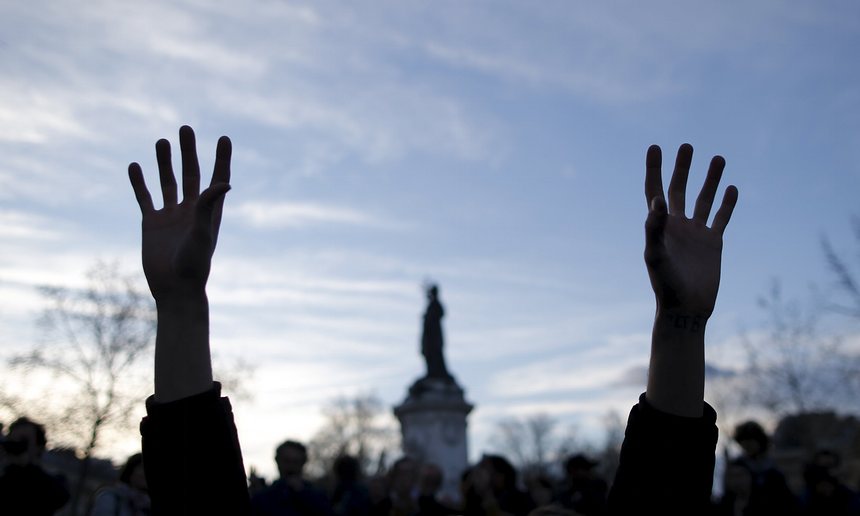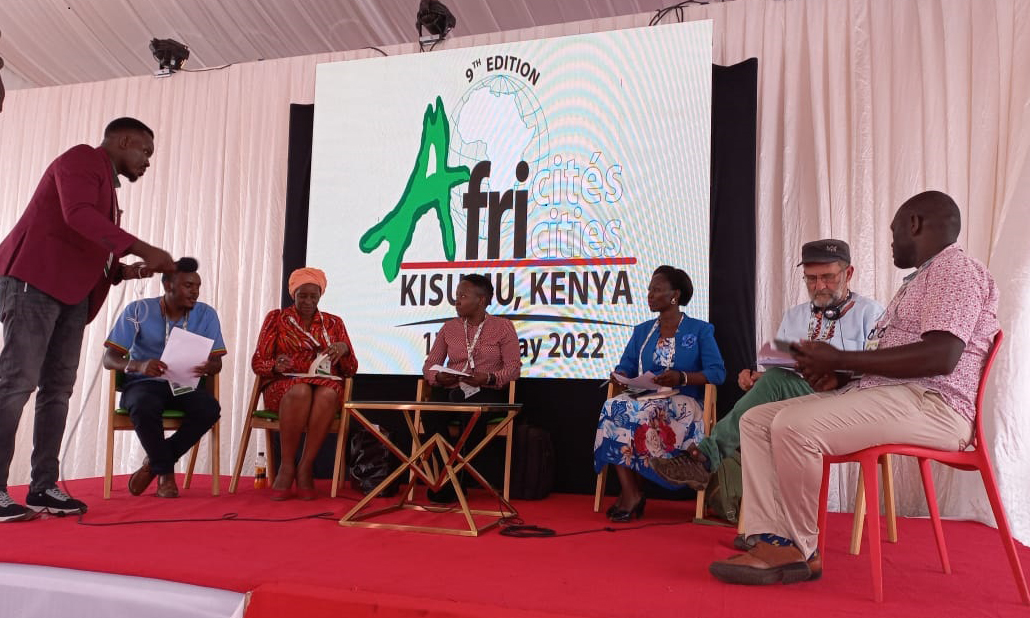
Public space is a generator of democratic
cities.’: Nuit Debout protesters in Paris’ Place de la
République.
Photograph: Christian Hartmann/Reuters
On a grey and drizzly April
morning just steps away from the University of Barcelona, dozens of men and
women, holding protest banners and wearing slogan-emblazoned T-shirts, stormed
into a branch of CatalunyaCaixa bank, chanting “We will never be defeated!”
Within
a matter of minutes, the floor was scattered with paper, the walls plastered in
posters and stickers. The room was charged with the anger and joy of protest.
Bank employees sat sheepishly in a corner, as the protesters continued to sing
and shout; police stood across the street, watching.
The
protesters were part of La PAH (Plataforma de Afectados por la Hipoteca, or
“Mortgage Victims Platform”), a grassroots movement made famous when its former
spokeswoman, Ada Colau, was elected Barcelona mayor. PAH campaigns against the tenant evictions and mortgage repossessions that have swept Spain following the
financial crisis.
The
group has claimed to have stopped thousands of evictions, and their “action” on
5 April was part of their latest campaign, against the investment banking firm
Blackstone Group, which according to PAH bought 90,000 mortgage assets from
CatalunyaCaixa and began trying to evict people. “We occupy banks very often,
maybe once a week,” said PAH member Santi Mas de Xaxàs. “In Barcelona, private
interests and speculators – both national and international – are pushing
people out. The banks are being protected while people’s rights are being
violated. We fight against all this, and for the right to decent housing.”
These
evictions – largely done in the name of private sector-led “regeneration” – are
merely one part of a wider whole, in which cities are becoming ever more
exclusive. The group’s protest at the bank deliberately coincided with the
latest United Nations’ Habitat III “thematic meeting” held at the
University of Barcelona, which discussed the future of public space and
housing. It’s all building to October’s main, high-profile summit in Quito, the
first Habitat summit in 20 years. Much has changed since the last iteration,
Habitat II, in 1996, and this year’s event – tasked with putting forward a “new
urban agenda” – seeks to align urban policies worldwide with the major
challenges facing cities and their inhabitants.
It comes at a critical time. Spanish
grassroots groups such as PAH and the “corrala” movement of people living in abandoned buildings are being
joined by countless more around the world, such as the Focus E15 mothers fighting their evictions by occupying the
Carpenter’s Estate in Stratford, east London, all demanding more or less the
same thing: a fairer, more democratic city in the face of rampant property
speculation and privatised public space.
The call to arms at the Habitat III
meeting reflected this desire for inclusivity: all people should have equal
access to public services, to housing, to public space; all should be able to
participate in shaping places that include everyone. “Speculation is turning
public spaces into contested spaces and generating inequalities,” Barcelona
mayor Ada Colau told the Habitat III meeting. “Gaps between citizens are being
widened. Public spaces should be for the public good.”
PAH protest placards
As the conversation continues at the
level of UN-Habitat meetings, so the actions continue on the ground in cities
across the world. What the protesters want is their “right to the city”, as
notably championed by British geographer David Harvey, who called it “the exercise of a collective
power to reshape the process of urbanisation”. Now, as Harvey
explains, that “right” is mostly restricted to a small political and economic
elite who shape cities after their own desires.
Some city governments are waking up
to the idea, though. São Paulo has a Right to the City Coordination,
established as part of their relatively new Municipal Secretariat for Human
Rights and Citizenship (SMDHC), which aims to create public policies for a more
inclusive, participative city. This is perhaps unsurprising in Brazil, a
country in which the City Statute law, passed in 2001, enshrines the right to
the city in the form of a new legal-urban order to provide land access and
equity in Brazil’s large metropolitan centres. The law seeks to prioritise the
social, rather than commercial, function of urban land.
“We know that society is demanding
new forms of participation,” says Esther Madeline LeBlanc, the deputy
coordinator of the initiative in São Paulo. “The right to the city is important
in assuring human rights, and must be realised with more social participation,
ensuring a democratic administration of the city. We want a city in which
public space is central in social interaction among all citizens: a city made
for people.”
It is in public space – the street, the square, the park –
that this right to the city is most often voiced and demanded. The protests in Istanbul’s Taksim Square, the occupation of
Zuccotti Park in New York, the umbrella revolution in the streets of Hong Kong
and now the Nuit Debout protests in Paris’ Place de la République: public space is
the threatened sphere in which citizens can demand change. And these movements
have in turn given the issue of public space more visibility.
A key concern is giving all
groups a say in shaping the kind of city they want to see. The Because I am a Girl urban programme, for example, aims to
improve safety for adolescent girls in cities, by involving them in workshops
and activities where they can voice and map how their public spaces and
transport networks make them feel unsafe, and what improvements could be made.
At the same time, it builds their capacity for meaningful participation in
urban development and governance: girls are encouraged to review existing city
policies and discuss how to amend them. The programme is currently active in
five cities: Delhi, Hanoi, Kampala, Cairo and Lima.
“We
need a multitude of perspectives in participation to ensure we are building
inclusive, resilient cities with social cohesion,” says Kathryn Travers,
director of Women
in Cities International, who have partnered with Plan International
and UN-Habitat on the programme. Enabling these girls to have a say in shaping
better public spaces is critical in a context where women around the world
continue to face harassment and violence in the urban realm: of the girls that
the programme have worked with, 24% of them said that they never feel safe in
public places. “It’s crucial that women and girls are consulted,” Travers adds.
“Gender gaps in cities lead to exclusion in public spaces. In some cities,
upwards of 90% of women experience daily sexual harassment in public space.”
While the Because I am a Girl urban programme can only make
policy recommendations, other governing bodies are moving towards greater
public involvement in urban change. Pla Estel, a Barcelona-based initiative, is working with
the city government on a “youth participatory process” that works to understand
young people’s needs in public space and feed this back into the city’s plans.
In Madrid, the council is undertaking 109 neighbourhood regeneration projects
in participation with local residents.
As Raquel del Rio, part of
Madrid’s sustainable urban development team, explains when we meet in Barcelona,
the city council has been helping people in investment-starved places to make
improvements to their housing and public space, by providing them with access
to funds and other resources. Larger assembly meetings are also held with all
of Madrid’s neighbourhood districts to establish what improvements people want
to see locally. And there has been massive public involvement in the
revitalisation of the Plaza de España in the city centre: more than 30,000
ideas from citizens have been gathered, and later this year the public will
vote on which scheme they want to be taken forward. It’s the biggest
participation project ever in Madrid.
The
goal, in other words, is for trashing bank branches to become a thing of the
past. Again and again, better involvement of citizens in urban development was
recommended at the Habitat III meeting as the key to achieving more inclusive
cities. “We need meaningful, transparent, participatory processes,” said
Puvendra Akkiah, a planner for the city of Durban. “There are no viable public
spaces without communities, and no viable communities without public space:
public space is a generator of democratic cities.” But until those public
spaces are more accessible, housing more inclusive and cities more
democratically managed, these occupations and protests are likely to continue
unabated.


